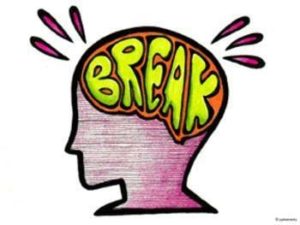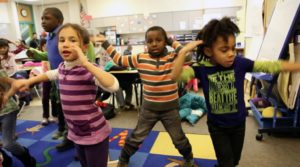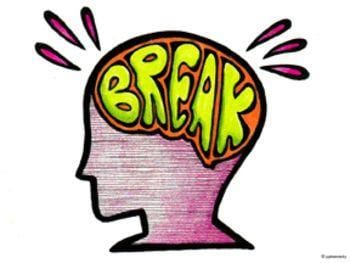Student Contributor: M. Foraker
 Brain Breaks can be used for individual students or for whole group. These brain breaks for correction are used when a specific student or students are off task and need some sort of movement to release energy and focus their brain back onto the lesson or activity.
Brain Breaks can be used for individual students or for whole group. These brain breaks for correction are used when a specific student or students are off task and need some sort of movement to release energy and focus their brain back onto the lesson or activity.
For specific students, brain breaks can be something quick and effective for the child to release energy when he or she is off task. These brain breaks can be some type of movement that the student and teacher have an agreement on such as taking a lap around the classroom, push-ups or sit-ups off to the side, standing/stretching, and more. As for whole class brain breaks, these can also be used when the entire class seems to be off task and wiggly. This type of whole class movement can be stretching, using dance videos, jumping jacks while counting, short games, and more. These can be very useful with young students who have a hard time sitting still and need to get some “wiggles” out during a lesson.
 This tool is used in the corrective phase because it will be used to correct off task and moving behavior that is disruptive to either a student, students, or the teacher. The tool is used as a short movement break to redirect a specific students or students back on track if needed. This tool can be used in the teacher directed or collaborative phase because the teacher will decide if the brain breaks for correction are needed. The teacher will notice if the class is off task and therefore make the decision of using a brain break to release energy and refocus the students' brains back on track. For specific students, the teacher and student will collaborate in coming up with a movement break the student can use if he or she is off task during a lesson.
This tool is used in the corrective phase because it will be used to correct off task and moving behavior that is disruptive to either a student, students, or the teacher. The tool is used as a short movement break to redirect a specific students or students back on track if needed. This tool can be used in the teacher directed or collaborative phase because the teacher will decide if the brain breaks for correction are needed. The teacher will notice if the class is off task and therefore make the decision of using a brain break to release energy and refocus the students' brains back on track. For specific students, the teacher and student will collaborate in coming up with a movement break the student can use if he or she is off task during a lesson.
More Information –
Tool Source: Physical Education class at Eastern Washington University



I have used this strategy in my 1st-grade classroom of 18 in a rural area. This tool has worked great in the classroom. There are always those days where the students have extra energy where they can’t seem to stay in their seats during direct instruction and need to wiggle around. I had the students stop everything they’re doing, and either run in place, shake it out, do a short exercise, or a short game. Students enjoy doing this a lot and it can also be used for transitioning into another activity or lesson. By having students utilize these brain breaks, they were able to focus more closely and be ready for whatever is coming their way! Something I may need to work on with this strategy is definitely making sure everyone is backed away from their desk and other students so they aren’t bumping things and their peers. Overall, this has worked great in the classroom and is a tool I will continue to use.
This tool was used in a rural 2nd grade classroom with 20 students. This tool was easy to prepare for, the most difficult part was to find specific brain break activities that worked for my students. This tool was easy to teach because the brain breaks are fun and engaging for kids. Using the brain breaks was easy, the hard part that I found was getting the students back on task after. I had success using this tool when my students were off task or losing motivation during a long school day. The students understood the role of this tool and liked participating with it, as I mentioned earlier the difficult part is the transition back to learning after the brain breaks. An adjustment that could make this tool even better would be advice for how to transition after a brain break and get students back to work now that this corrective strategy has been used.
I used this tool in my first grade classroom of 20 students in a rural area. Students in my classroom really enjoy being able to move so this was a great way to get their engagement back on track and help them get energy out. This tool was easy to prepare in that there were many options on gonoodle and youtube to choose from. Towards the end of the day we did a brain break as students were seeming tired and it can be hard for them to be sitting in their learning spaces for so much time. It was a success seeing students be active and have a fun break between instruction. They used the specific tool of doing dance videos, but I have seen them do similar movements to what the toolbox had mentioned in doing jumping jacks during a math lesson. I think using movement through brain breaks can be a great tool for students because it can correct where there may be misbehavior and a need for managing the classroom’s energy levels. This corrective tool is great for helping students feel connected with their classroom and students through guided expectations can understand how to safely participate.
Brain Breaks for Correction
I used this tool in a 4th grade classroom with 20 students. I picked this tool to use in the corrective stage because I have heard a lot about break breaks to release energy but have never seen it. I also picked this one because I feel as we are getting closer to spring break the students have had tons more energy than usual. The brain break that my mentor teacher and I settled on was simply doing nothing for two minutes. We decided to do it right after recesses when they are typically the loudest. We had the student close their eyes and put their heads down for two whole minutes. We made sure to tell the students that this was to just give their brains a break and that they were not in any trouble. I think this was a great tool. The students responded well to it, they were quiet, and they moved on to the next task very smoothly and timely. It was incredibly easy to introduce to the students because it was as simple as telling them we are going to take a few minutes to reset and calm our minds and they followed instruction very well.